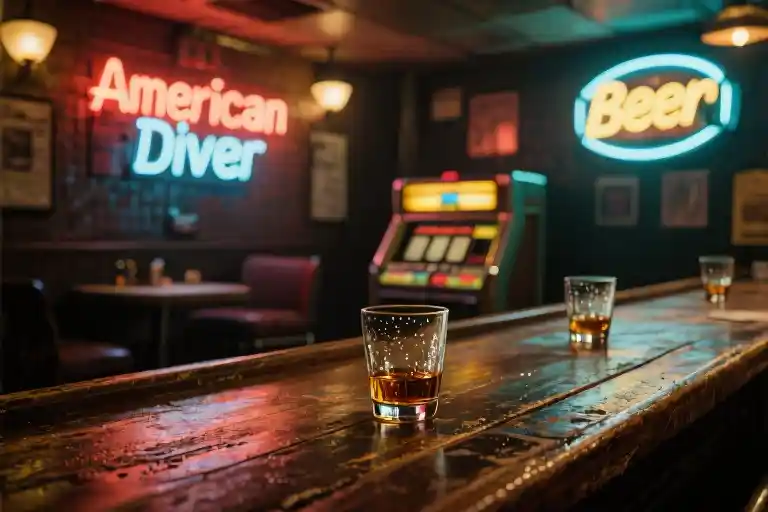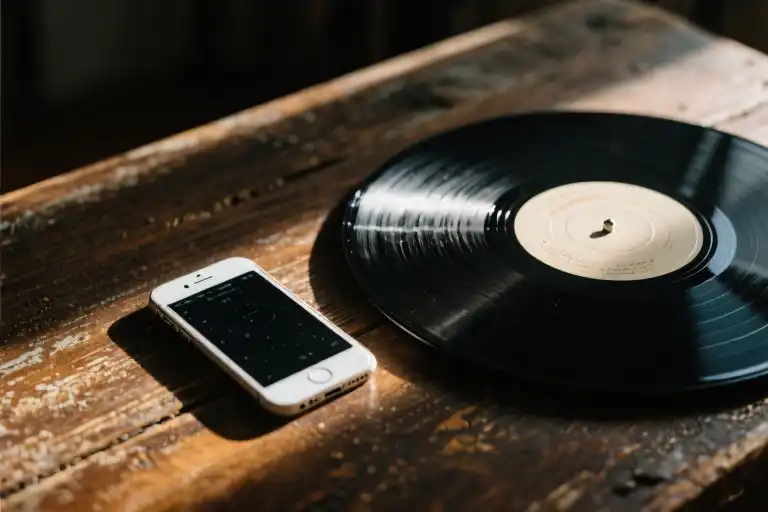“Here ya go, kid. That’ll be $1.75. Cash only. If you don’t have it, there’s an ATM right there.”
The metallic click of the can opener. The fizzy hiss of carbonation escaping. The condensation already forming on the aluminum before it even touched my palm. There it was—my first Miller High Life, the so-called “champagne of beers,” served in a Chicago dive bar where the floorboards stuck to my shoes and the air smelled like equal parts bleach, stale beer, and the ghost of a thousand Marlboro Reds.
I didn’t know it then, but that grimy aluminum can resting on a bartop polished smooth by decades of elbows would mark the beginning of a lifelong romance with dive bars. By last call, I’d spent less than fifteen dollars, absorbed enough secondhand smoke to qualify as a smoker, and walked out with that particular stumble reserved for college freshmen who’ve discovered freedom tastes like cheap lager. Best of all? Nobody even glanced at my questionable ID. In that moment, beneath flickering neon and a ceiling stained nicotine-yellow, I was home.
Dive bars operate on a sacred economy of cash and camaraderie. No velvet ropes, no dress codes—just the unspoken rule that if you can pay for your drink (in physical currency, like a civilized human), you belong. The bartender might call you “kid,” “honey,” or occasionally something saltier, but never “sir” or “ma’am.” The stools wobble, the bathrooms could double as crime scenes, and the regulars look like extras from a Cohen brothers film. And it’s perfect.
What makes these places magical isn’t just the affordability (though let’s be honest, where else can $30 buy you both intoxication and life advice from a Vietnam vet named Earl?). It’s the radical democracy of it all. CEOs and construction workers sidle up to the same bar. College professors debate metaphysics with truck drivers. Your jeans can be designer or thrift-store—as long as you don’t spill your beer, nobody cares. In an era of algorithmically determined social circles and curated Instagram lives, dive bars remain gloriously, defiantly analog.
Yet even as I write this, another beloved dive bar somewhere is turning off its neon for the last time. Rising rents, cashless payment trends, and generational shifts in drinking habits threaten these institutions. The very qualities that make them special—their unpolished authenticity, their cash-only simplicity—now make them vulnerable. But to lose them would mean losing more than just cheap drinks; we’d sacrifice one of the last places where strangers still become friends over shared ashtrays and jukebox selections.
So here’s to the dive bars—the sticky, smoky, splendid places where you’re always welcome as long as you’ve got a few crumpled bills and the good sense to know that happiness doesn’t come in a $20 cocktail glass. May their neon never fade.
Global Dive Bar Adventures
The neon sign flickered like a dying firefly as I pushed open the screen door of Red’s Repair & Refreshments outside Tulsa. Inside, a man in grease-stained overalls – who I’d later learn owned both the bar and adjacent tractor shop – slid me a can of Coors Banquet without asking. ‘We don’t get many strangers here,’ he said, wiping his hands on a rag that might have been clean during the Reagan administration. That’s how I learned the first rule of rural Oklahoma dive bars: if the bartender also fixes farm equipment, you’re in for stories better than anything on Netflix.
Three years later, I found myself in St. Petersburg, Russia, staring at a shot glass of vodka that cost less than a metro ticket (65 cents, to be precise). The man next to me – introduced only as ‘Mikhail the Terrible’ – demonstrated proper Soviet-era smoking technique: ‘Inhale like capitalist pig, exhale like communist hero.’ By midnight, we’d progressed to toasting everything from perestroika to the superiority of Russian microwave ovens, our voices rising with each 30-rouble refill. That’s the magic of dive bars abroad – they transform cultural exchange into something between a drinking game and an oral history project.
Budapest offered perhaps the most surreal experience: a crumbling Soviet-era cinema turned dive bar, where rusted film reels still dangled from the ceiling like metallic vines. The bartender, wearing a Pantera t-shirt and what appeared to be East German military boots, served me pálinka from a unlabeled bottle while explaining Hungarian punk rock’s influence on the 1989 revolution. Between shots, we examined graffiti left by patrons over decades – layers of political slogans, band logos, and existential musings that formed a tipsy timeline of Central European history.
These global dive bar encounters share DNA with their American cousins but evolve fascinating local mutations:
- The Russian Factor: Where US dives measure longevity in decades, their Russian counterparts count generations. Expect tsar-era building foundations, Soviet plumbing, and post-glasnost attitudes all coexisting under one nicotine-stained roof.
- Eastern European Time Warps: Former communist states specialize in repurposed industrial spaces where the decor (and sometimes the liquor) appears frozen in 1987. Bonus points if the jukebox plays Yugoslav rock.
- Latin American Social Hubs: Unlike the solitary drinker stereotype, many Central American dive bars function as neighborhood living rooms – complete with grandmothers drinking cerveza at 10am while watching telenovelas.
The throughline? Authenticity you can’t manufacture. Whether it’s a Chicago bar that’s kept the same Schlitz sign since 1972 or a Prague hole-in-the-wall serving communist-era beer, real dive bars wear their history like a favorite leather jacket – cracked, comfortable, and full of stories. They’re living museums where the exhibits drink with you, the artifacts stick to your shoes, and the guided tour involves a whiskey back and a pack of locals eager to explain why their hometown dive is the world’s best (even if you need Google Translate to understand half the insults).
Why We Love Dive Bars
There’s something profoundly honest about a dive bar. No velvet ropes, no dress codes, no $30 cocktails with names longer than the ingredients list. Just a dimly lit sanctuary where the only prerequisite for entry is having cash (preferably crumpled) and a willingness to be human among humans.
The Anti-Pretentious Manifesto
Walk into any upscale cocktail lounge these days and you’ll find yourself deciphering menus that read like PhD dissertations. “Seasonal artisanal mezcal infused with foraged Pacific Northwest mushrooms served in a hand-blown glass vessel aged in Tibetan singing bowls.” At $28 a pop, you’re not buying a drink—you’re purchasing an ego boost in liquid form.
Now contrast that with my local dive’s philosophy: “Beer’s in the cooler, liquor’s behind me. Want ice? Here’s a bucket.” The most complex decision you’ll make is whether to get your whiskey neat or with a splash of whatever soda gun option still works. No performance, no posturing—just alcohol doing exactly what alcohol was meant to do.
Where Strangers Become Temporary Family
I’ll never forget the night a Vietnam vet named Ray taught me how to properly smoke a cigar while explaining quantum physics. Or when Bev—who may or may not have been Bob Dylan’s childhood piano teacher—held court for three hours about Minnesota’s punk scene in the 70s, her cigarette ash growing impossibly long without ever falling. These aren’t curated “experiences” you pay for; they’re spontaneous human connections that only happen when people aren’t staring at screens.
Dive bars foster what sociologists call “weak tie” relationships—those beautiful, low-stakes interactions with people you’d never meet in your daily routine. The hardware store clerk debating string theory. The retired trucker with encyclopedic knowledge of 60s soul music. These momentary connections combat what researchers are calling our modern “epidemic of loneliness.”
The Radical Philosophy of ‘Enough’
In a world constantly screaming “more!”—more followers, more upgrades, more curated perfection—dive bars whisper the revolutionary idea: “This is plenty.” The stools don’t need to be designer to hold you up. The glasses don’t need to be crystal to deliver the goods. The company doesn’t need to be Instagram-famous to be worthwhile.
There’s democratic beauty in how dive bars flatten social hierarchies. Your job title doesn’t matter here. Neither does your credit score or how many likes your last post got. The only currency that counts is whether you can hold a conversation and maybe spot someone a dollar when the jukebox eats their quarter.
The Last Bastion of Authentic Interaction
Unlike algorithm-driven social media that reinforces our existing bubbles, dive bars force organic cross-pollination. You’ll find yourself talking to:
- Construction workers debating opera
- Grandmothers schooling millennials at pool
- PhD candidates arguing sports with high school dropouts
These spaces preserve the nearly lost art of face-to-face conversation where your wit matters more than your wifi speed. As one grizzled regular told me between sips of Busch Light: “Kid, nobody ever looked up from their phone and said ‘Damn, I wish I’d spent more time scrolling.'”
A Living Rejection of Perfection Culture
The stained ceiling tiles? They’re proof people have laughed here for decades. The wobbly table? It gives your group something to complain about together. The bathroom graffiti? It’s the purest form of democratic art. In our filtered, Facetuned world, dive bars stand as temples to beautiful imperfection—where the cracks aren’t flaws but character.
Next time you walk past that unassuming door with the flickering neon, remember: you’re not just entering a bar. You’re stepping into one of the last spaces where humanity hasn’t been polished into something unrecognizable. Where $5 still buys you a drink and a story. Where enough is actually enough.
How to Spot a True Dive Bar
You don’t find authentic dive bars—they find you. Like stumbling upon a speakeasy without the password, the magic lies in their unapologetic lack of pretension. Here’s how to separate the real deal from wannabes with hipster mustaches and $14 avocado toast.
1. The Exterior Should Look Like It Survived a Natural Disaster
A proper dive bar’s facade wears its history like a badge of honor. Peeling paint that reveals decades of color choices, a flickering neon sign missing half its letters (the ‘S’ in ‘Budweiser’ has been dark since Reagan’s presidency), and a door that either sticks or won’t close properly—these aren’t flaws, they’re credentials. If you can clearly read the establishment’s name from across the street, you’re probably at a themed cocktail lounge disguised as a dive.
2. Cash is King (and Cards Are Heretical)
The moment you see a Square reader next to the register, your dive bar radar should ping. Authentic joints operate on an all-cash economy, often with an ATM that charges $3.50 per withdrawal and looks like it was installed during the Clinton administration. This isn’t inconvenience—it’s a filter keeping out those who’d complain about the lack of oat milk latte options.
3. The Ceiling Tells the Story
Look up. Those aren’t water stains—they’re the fossilized ghosts of ten thousand exhaled Marlboros. A true dive bar’s ceiling resembles an abstract art piece created by decades of nicotine and poor ventilation. Bonus points if the tiles are missing or if there’s visible duct tape holding fixtures together.
4. The Regulars Could Be Extras from a Tarantino Film
Every genuine dive has its cast of characters: the leather-faced woman who’s occupied the same stool since Nixon resigned, the guy who might be a retired cop or possibly an escaped convict, and at least one patron wearing sunglasses indoors at 11am. They’re not decorations—they’re the living archives of the bar’s history. If they nod at you like you belong, consider it a higher honor than any Michelin star.
5. The Bathroom is a Test of Character
When the restroom door has more graffiti than a subway car and the lock hasn’t worked since the Berlin Wall fell, you’re in the right place. A true dive bar bathroom isn’t unsanitary—it’s archaeologically significant. The mirror will be either missing, cracked, or clouded beyond usefulness, and the soap dispenser will either be empty or contain a mysterious pink liquid.
6. The Drink Menu is Whatever’s Within Arm’s Reach
No leather-bound cocktail books here. The bartender’s mental inventory consists of: beer (can or bottle), whiskey (with or without coke), and maybe a vodka option for the heathens. If you ask for something complicated, you’ll either get laughed at or receive a completely different drink with the same name your great-grandmother would recognize.
7. The Jukebox Plays Only Legends and Regrets
None of this Spotify playlist nonsense. A proper dive bar jukebox contains exactly three types of music: classic rock that was already classic when the bar opened, country songs about cheating and trucks, and that one inexplicable polka album nobody admits to selecting. The selection hasn’t changed since 1998, and that’s how regulars like it.
8. Time Operates Differently Here
Clocks either don’t exist or show wildly different times. Happy hour isn’t a marketing ploy—it’s a way of life. The TV above the bar is permanently tuned to either a 24-hour news network or a baseball game from 2007, depending on which remote control still has batteries.
9. The Decor Achieves Maximum Clutter Chic
License plates from states the owner has never visited? Check. Framed photos of celebrities who definitely never came here? Absolutely. At least one item that could be either modern art or something left behind during last call? You bet. The walls tell stories in layers—peel back one poster and you might find a 1980s concert flyer underneath.
10. You Leave With More Than You Came For
Whether it’s life advice from a stranger, the recipe for a mystery shot called “The Widowmaker,” or just the comforting knowledge that places like this still exist, authentic dive bars give you something no craft cocktail lounge ever could—the sense that you’ve momentarily slipped into a world where time, trends, and pretensions don’t matter. And that’s worth more than any artisanal ice cube could ever be.
The Vanishing Act: Why Dive Bars Are Disappearing
The neon signs are flickering out. The cash-only signs are being replaced by QR code menus. The jukeboxes that once played Springsteen on repeat now sit unplugged in corners. Across America and beyond, our beloved dive bars are vanishing at an alarming rate – and with them, we’re losing something far more valuable than cheap beer and sticky floors.
By the Numbers: A Closing Time Crisis
In Chicago alone, 37% of classic dive bars have shuttered in the past decade. New York’s East Village has lost over 60% of its historic watering holes since 2000. The math is simple: rising rents + changing habits = last call for institutions that once defined neighborhood culture. These aren’t just business closures – they’re cultural extinctions.
What makes these losses particularly painful is how dive bars function as social equalizers. When a dive closes in a gentrifying neighborhood, it’s often replaced by craft cocktail bars charging $18 for drinks that would get laughed out of a proper dive. The regulars – the retired cops, the night shift workers, the artists barely making rent – get priced out of their own community gathering spaces.
Generation Gap: Why Z Isn’t Buying the Next Round
Three seismic shifts are accelerating the dive bar die-off:
- The Cashless Conundrum
- 83% of Gen Z consumers report rarely carrying cash
- Many classic dives still operate on “greenbacks only” policies
- ATM fees (that sacred dive bar revenue stream) deter digital natives
- The Sobriety Shift
- 25% of college students now identify as non-drinkers
- Mocktail culture clashes with dive bar economics ($5 for soda water doesn’t pay the rent)
- Health-conscious trends favor venues with organic juice over well whiskey
- The Social Media Paradox
- Younger drinkers prefer “Instagrammable” venues over authentically gritty spaces
- 72% of millennials admit choosing bars based on photo opportunities
- Dive bars thrive on real interaction in a world addicted to digital connection
The Ripple Effect: More Than Just Lost Watering Holes
When a dive bar closes, we don’t just lose a place to drink – we lose:
- Community Hubs: Where else can a construction worker, a PhD student, and a retired jazz musician have equal footing?
- Story Vaults: Those bartenders who remember everyone’s name and life story
- Cultural Archives: The signed dollar bills, the decades-old graffiti, the photos yellowing behind the bar
- Social Safety Nets: For many regulars, the dive bar staff are their only daily human contact
Last Call to Action
The solution isn’t nostalgia – it’s adaptation and advocacy. Here’s how you can help:
- Vote With Your Wallet
- Make a point to visit local dives at least twice a month
- Always tip in cash (even if paying with card)
- Buy merch (those t-shirts help more than you think)
- Become a Regular
- Learn bartenders’ names
- Introduce yourself to other regulars
- Offer to help with small tasks (changing kegs, taking out trash)
- Document the Culture
- Interview longtime bartenders
- Photograph the unique details (with permission)
- Share stories on social media with #SaveTheDive
- Support Preservation Efforts
- Petition for historical designation for iconic dives
- Advocate for small business rent control
- Back “Dive Bar Appreciation” events in your city
The lights may be dimming, but it’s not last call yet. Every PBR cracked open, every dollar bill taped to the wall, every conversation struck up with a stranger helps keep this vital piece of our social fabric alive. Your local dive doesn’t need fancy cocktails or artisanal pickles – it just needs you to walk through that door, cash in hand, ready to be part of something real.
How You Can Save Your Local Dive Bar
The neon signs may be flickering, but it’s not too late to keep dive bar culture alive. Here’s your actionable guide to becoming a patron saint of these vanishing democratic drinking spaces.
1. Pay Like It’s 1999 (Because They Literally Can’t Take Cards)
- Carry cash like it’s your civic duty. That $20 bill in your wallet? That’s two beers, a shot, and a generous tip that keeps the lights on.
- Skip the ATM fees by planning ahead. Consider it a small tax for preserving cultural heritage.
- Tip in coins when you’re down to your last dollars – bartenders at real dives will appreciate the gesture (and probably buy you one back).
2. Become a Regular (Or At Least Pretend To Be)
- Pick your stool and claim it. Consistency builds relationships in dive bars faster than Tinder matches.
- Learn the bartender’s name and their drink of choice. Next time you see Bev lighting her seventh cigarette, slide her that Miller High Life she’s been eyeing.
- Adopt the house rules: If the jukebox plays Skynyrd on repeat, don’t be the heathen who queues Drake.
3. Start Conversations That Don’t Begin With ‘What’s Your Instagram?’
- Ask about the decor: That yellowed photo behind the bar? Could be Elvis, could be someone’s uncle Dave – either way, it’s a story starter.
- Challenge someone to pool and lose graciously. Your prize? Free advice about carburetors/life/why the Cubs will never win again.
- Bring a notebook if you’re shy. Scribbling “Tell me your best bar story” on a coaster works like magic.
4. Institute ‘Dive Bar Thursday’ (Or Any Weeknight)
- Gather 3 friends on traditionally slow nights. Your $40 tab means more on Tuesday than Saturday.
- Order the weirdest shot behind glass. That neon green liquid? It’s somebody’s family recipe (probably).
- Document properly: Take one polaroid for the wall, not 47 Instagram stories. Authenticity matters.
5. Fight Gentrification With Your Wallet
- Buy a dive bar t-shirt even if it’s ugly. That $25 goes further than you’d think.
- Host your birthday there instead of some mixology lab. Your friends will thank you when they’re not paying $18 for rosemary-infused disappointment.
- Defend their existence at community meetings. “Historical preservation” includes places where history was made over whiskey sours.
The Last Call
Next time you pass that suspicious-looking door with the peeling Schlitz sign, remember: you’re not just walking into a bar. You’re stepping into:
- The last place where your phone battery doesn’t matter
- A time capsule of unfiltered human connection
- Someone’s livelihood
- What sociologists call a “third space” (but we call paradise)
Push open that sticky door before it becomes another damn juice bar. Your stool’s waiting.
Closing Thoughts: The Last Call for Dive Bars
The neon sign flickers as you push open the door, the same way it did when you first discovered this place. That first Miller High Life still tastes like liberation – crisp, uncomplicated, and priced like it’s 1999. The bartender nods in recognition, already reaching for your regular. Somewhere in the back, the jukebox plays a Springsteen song about glory days. You take your seat at the bar, the vinyl stool creaking familiarly under your weight. This is where you belong.
Dive bars aren’t just businesses – they’re living scrapbooks of our collective memory. Every scuff mark on these floors tells a story. Every stain on the ceiling holds a secret. That sticky spot on the bar? That’s where someone proposed with a ring from a gumball machine. The bathroom graffiti contains more wisdom than most philosophy textbooks. These places are museums where the exhibits drink with you.
Yet the signs of change are everywhere. The ATM collects dust as card-only millennials hesitate at the door. The ‘Help Wanted’ sign behind the bar has yellowed with age. Across town, another dive converts into a craft cocktail lounge with $18 old-fashioneds and Edison bulbs. We’re losing something vital – not just cheap drinks, but the last truly democratic spaces where your credit score doesn’t determine your seat at the bar.
So here’s my plea: Next time you walk past that dimly lit doorway with the crooked sign, don’t just reminisce – go in. Order that $3 beer in a frosted mug. Tip in cash. Ask the guy next to you about his tattoo. Let the jukebox surprise you. Laugh at jokes you don’t fully understand. These places only survive if we use them – really use them, not just Instagram them.
The magic of dive bars has always been their stubborn resistance to trends. They don’t need mixologists or artisanal ice. Their charm comes from what they lack: pretension, algorithms, dress codes. In a world that constantly demands we upgrade, dive bars remain gloriously unupdated. Their only requirement is that you show up as yourself – no filters, no subscriptions, no premium memberships.
So raise your glass (plastic cup acceptable) to these endangered institutions. That first sip still tastes like belonging, like community, like enough. The door’s still open – for now. Walk through it while you can. Because when these places disappear, we won’t just lose bars – we’ll lose the last rooms where time moves slower, conversations last longer, and your worth isn’t measured by your wallet.
Push open that door. You’re home.





